Optimization and Experiment on Key Parameters of Harvester for Auricularia auricula
Abstract
:1. Introduction
2. Working Principle of Auricularia auricula Harvester
2.1. Structure of Harvester
2.2. Operation Process
2.3. Operation Quality Parameters
3. Materials and Methods
3.1. Test Materials
3.2. Test Conditions and Process
3.3. Test Instruments
3.4. Test Methods
3.4.1. Determination of Factor Parameters
- (1)
- Speed
- (2)
- Frequency
- (3)
- Distance
3.4.2. Measurement of Response Index
- (1)
- Bacterial rod harvesting productivity Y1For the number of fungus rods harvested by Auricularia auricula harvester for 1 h, each group of tests was repeated 3 times, and the average of the results of the 3 tests was taken. The calculation formula iswhere Q is the number of collected bacteria rods, rods.
- (2)
- Harvesting qualification rate Y2The amount of 500 g of the Auricularia auricula in the collected aggregate box was randomly selected and weighed, and the total number of Auricularia auricula and the number of damaged Auricularia auricula were counted. According to the Auricularia auricula grade requirement in the national standard of Auricularia auricula (GB/T 6192—2019) [25], the product was sieved with a 15 mm sieve, and then the number of Auricularia auricula passing through the sieve was counted. Each group of tests was repeated 3 times, and the average of the results of 3 tests was taken. The calculation formula isIn the formula, n1 is the total number of Auricularia auricula, each; n2 is the number of damaged Auricularia auricula, each; n3 is the number of Auricularia auricula that failed to pass through the 15 mm screen, each.
- (3)
- Breakage rate Y3The amount of 500 g of the Auricularia auricula in the collected aggregate box was randomly selected and weighed, and the total number of Auricularia auricula and the number of damaged Auricularia auricula were counted. Each group of tests was repeated 3 times, and the average of the results of 3 tests was taken. The calculation formula isIn the formula, n1 is the total number of lugs, each; and n2 refers to the number of damaged lugs, each.
3.4.3. Experimental Design
4. Results and Discussion
4.1. Bacterial Rod Harvesting Productivity
- (1)
- Regression analysis of recovery productivity
- (2)
- Analysis of recovery efficiency and response surface of each parameter
4.2. Harvest Qualification Rate
- (1)
- Regression analysis of recovery qualification rate
- (2)
- Response surface analysis of qualified rate and parameters.
4.3. Recovery Failure Rate
- (1)
- Regression analysis of recovery failure rate
- (2)
- Failure rate and response surface analysis of parameters
4.4. Parameter Optimization
4.5. Test Verification
5. Conclusions
Author Contributions
Funding
Institutional Review Board Statement
Data Availability Statement
Acknowledgments
Conflicts of Interest
References
- Shuang, Z.; Chengbo, R.; Yu, L.; Feng, X.; Shouxian, W.; Changling, D.; Jie, C.; Xiaoya, W. Extraction of a soluble polysaccharide from Auricularia polytricha and evaluation of its anti-hypercholesterolemic effect in rats. Carbohydr. Polym. 2015, 122, 39–45. [Google Scholar] [CrossRef]
- Jie, Y.; Hong, L.; Zhaolin, Z.; Hua, W.; Yong, Z.; Xin, L.; Jinchuan, X. Biological Characteristics and Domestication of Wild Au-ricularia auricula Aa-015. China Edible Fungi 2018, 37, 22–24. [Google Scholar] [CrossRef]
- Wenfeng, L.; Hongwen, B.; Fenghua, H. Present Situation and Countermeasures and Recommendations of Development of Auricularia auricula Industry in China. North. Hortic. 2021, 7, 142–147. [Google Scholar] [CrossRef]
- China Edible Fungi Association. Analysis on the results of the national edible fungi statistical survey in 2020. China Edible Fungi 2022, 41, 85–91. [Google Scholar] [CrossRef]
- Nana, C.; Hao, Z.; Xin, Z.; Siyu, L.; Jiaojiao, W.; Yizhen, W.; Mingliang, J. Polysaccharides from Auricularia auricula: Preparation, structural features and biological activities. Carbohydr. Polym. 2020, 247, 116750. [Google Scholar] [CrossRef]
- Yue, S.; Liang, L. Structural characterization and antioxidant activity of polysaccharide from four ariculariales. Carbohydr. Polym. 2020, 229, 115407. [Google Scholar] [CrossRef]
- Irina, A.K.; Costa, R.; Tatinna, K.K.; Olga, N.G.; Yanguo, S. Chemical composition and nutritional value of the mushroom Auricularia auricula-judae. J. Food Nutr. Res. 2015, 3, 478–482. [Google Scholar] [CrossRef]
- Wei, X.; Li, L.; Yingying, W.; Yibin, W.; Shenxia, W.; Yunyun, G.; Yanyao, L.; Guogang, Z.; Weisan, P.; Xinggang, Y. Design and evaluation of a novel potential carrier for a hydrophilic antitumor drug: Auricularia auricular polysaccharide -chitosan nanoparticles as a delivery system for doxorubicin hydrochloride. Int. J. Pharm. 2016, 5111, 267–275. [Google Scholar] [CrossRef]
- Mingyou, W.; Chengji, X.; Weidong, S.; Quanrong, J.; Xingbo, D.; Minghan, X. Design and experiment of the edible fungus automatic mode bagging machine. J. Chin. Agric. Mech. 2020, 41, 94–98. [Google Scholar]
- Mingyou, W.; Weidong, S.; Dehuan, Z.; Tianhang, D.; Jiaoling, W.; Jinji, W.; Fan, Z. Design and performance test of an all-in one fungus stick preparation machine for automated bagging, socket forming and rod insertion. Acta Edulis Fungi 2020, 27, 164–171. [Google Scholar] [CrossRef]
- Mingyou, W.; Weidong, S.; Shuaiyang, W.; Dehuan, Z.; Jiaoling, W.; Tianhang, D. Research on production technology of Auricularia auricula in China. J. Chin. Agric. Mech. 2022, 3, 98–102. [Google Scholar] [CrossRef]
- Yichich, C.; Suming, C.; Fenglin, J. Study of an Autonomous Fruit Picking Robot System in Greenhouses. Eng. Agric. Environ. Food 2013, 6, 92–98. [Google Scholar] [CrossRef]
- Wouter, B.; Tim, R.; Roi, R.; Sigal, B.; Jochen, H.; van Henten, E.J. Analysis of a motion planning problem for sweet pepper harvesting in a dense obstacle environment. Biosyst. Eng. 2016, 146, 85–97. [Google Scholar] [CrossRef]
- Barth, R.; Hemming, J.; van Henten, E.J. Design of an eye-in-hand sensing and servo control framework for harvesting robotics in dense vegetation. Biosyst. Eng. 2016, 146, 71–84. [Google Scholar] [CrossRef] [Green Version]
- Ziwen, C.; Mingjin, Y.; Yunwu, L.; Ling, Y. Design and experiment of tomato picking end-effector based on non-destructive pneumatic clamping control. Trans. Chin. Soc. Agric. Eng. 2021, 37, 27–35. [Google Scholar] [CrossRef]
- Wei, L.; Peng, W.; Ling, W.; Yiming, D. Design and Experiment of Flexible Gripper for Mushroom Non-destructive Picking. Transac-Tions Chin. Soc. Agric. Mach. 2020, 51, 28–36. [Google Scholar] [CrossRef]
- Mingsen, H.; Long, H.; Daeun, C.; John, P.; Yaoming, L. Picking dynamic analysis for robotic harvesting of Agaricus bisporus mushrooms. Comput. Electron. Agric. 2021, 185, 106145. [Google Scholar] [CrossRef]
- Reed, J.N.; Miles, S.J.; Butler, J.; Baldwin, M.; Noble, R. AE—Automation and Emerging Technologies: Automatic Mushroom Har-vester Development. J. Agric. Eng. Res. 2001, 78, 15–23. [Google Scholar] [CrossRef]
- Wenshuo, G.; Weidong, S.; Tianhang, D.; Jiaoling, W. Design of bacteria bottle clamping parts based on regression models. J. Math. 2020, 11, 1210. [Google Scholar] [CrossRef]
- Pérez-Montes, A.; Rangel-Vargas, E.; ManuelLorenzo, J.; Romero, L.; Santos, E.M. Edible mushrooms as a novel trend in the de-velopment of healthier meat products. Curr. Opin. Food Sci. 2021, 37, 118–124. [Google Scholar] [CrossRef]
- Mingyou, W.; Shuaiyang, W.; Weidong, S.; Dehuan, Z.; Jiaolong, W.; Tianhang, D. Current status and the prospect of research on mechanized harvesting; of Auricularia auricula in China. J. Chin. Agric. Mech. 2022, 9, 219–223. [Google Scholar]
- Jiachen, R.; Pengbo, W.; Qian, Y.; Feng, H. A Field-Tested Harvesting Robot for Oyster Mushroom in Greenhouse. Agronomy 2021, 11, 1210. [Google Scholar] [CrossRef]
- CN106973627A; Qhingkai, C. Auricularia auricula picking device and Auricularia auricula automatic picking device. Intellectual Property Publishing House Co., Ltd.: Beijing, China, 2017.
- CN10692291A; Guipo, J. Auricularia auricula harvesting equipment. Intellectual Property Publishing House Co., Ltd.: Beijing, China, 2017.
- CN212487693U; Zongqin, Z.; Shuguang, Z. A kind of Auricularia auricula harvesting equipment. Intellectual Property Publishing House Co., Ltd.: Beijing, China, 2021.
- Yue, X.; Jianmei, L.; Jian, L.; Xinyu, L.; Zhaoshan, W.; Lin, C. Production status and economic benefit analysis of Auricularia auricula in Dunhua City. Agric. Dev. Equip. 2019, 8, 60–61. [Google Scholar]
- He, W.; Qing, Z.; Han, L.; Ran, Z. Polynomial-based smooth trajectory planning for fruit-picking robot manipulator. Inf. Process. Agric. 2022, 1, 112–122. [Google Scholar] [CrossRef]
- Weibin, C.; Guodang, L.; Chi, N.; Liangliang, A.; Shuangping, Y.; Bangbang, C. Harvest performance test and parameter optimization of comb-type safflower-filaments picking head at same height. Trans. Chin. Soc. Agric. Eng. 2018, 22, 36–44. [Google Scholar] [CrossRef]
- Joonyoung, K.; HyeRan, P.; Inhoon, J.; Jaehyeon, K.; ByeonKwon, J.; KwangEun, K. Tomato harvesting robotic system based on Deep-ToMaToS: Deep learning network using transformation loss for 6D pose estimation of maturity classified tomatoes with side-stem. Comput. Electron. Agric. 2022, 201, 107300. [Google Scholar] [CrossRef]
- GB/T 6192-2019; State Administration of Market Supervision and Administration. China National Standardization Administration Black Fungus. China Agricultural Press: Beijing, China, 2019.
- GB/t5262-2008; General Administration of Quality Supervision, Inspection and Quarantine of the people’s Republic of China, national standard of China Quasi Management Committee test conditions of agricultural machinery General provisions of the method. China Agricultural Press: Beijing, China, 2006.
- GB/t67-2008; General Administration of Quality Supervision, Inspection and Quarantine of the people’s Republic of China, National Standardization Administration of China agricultural machinery production test method. China Agricultural Press: Beijing, China, 2006.
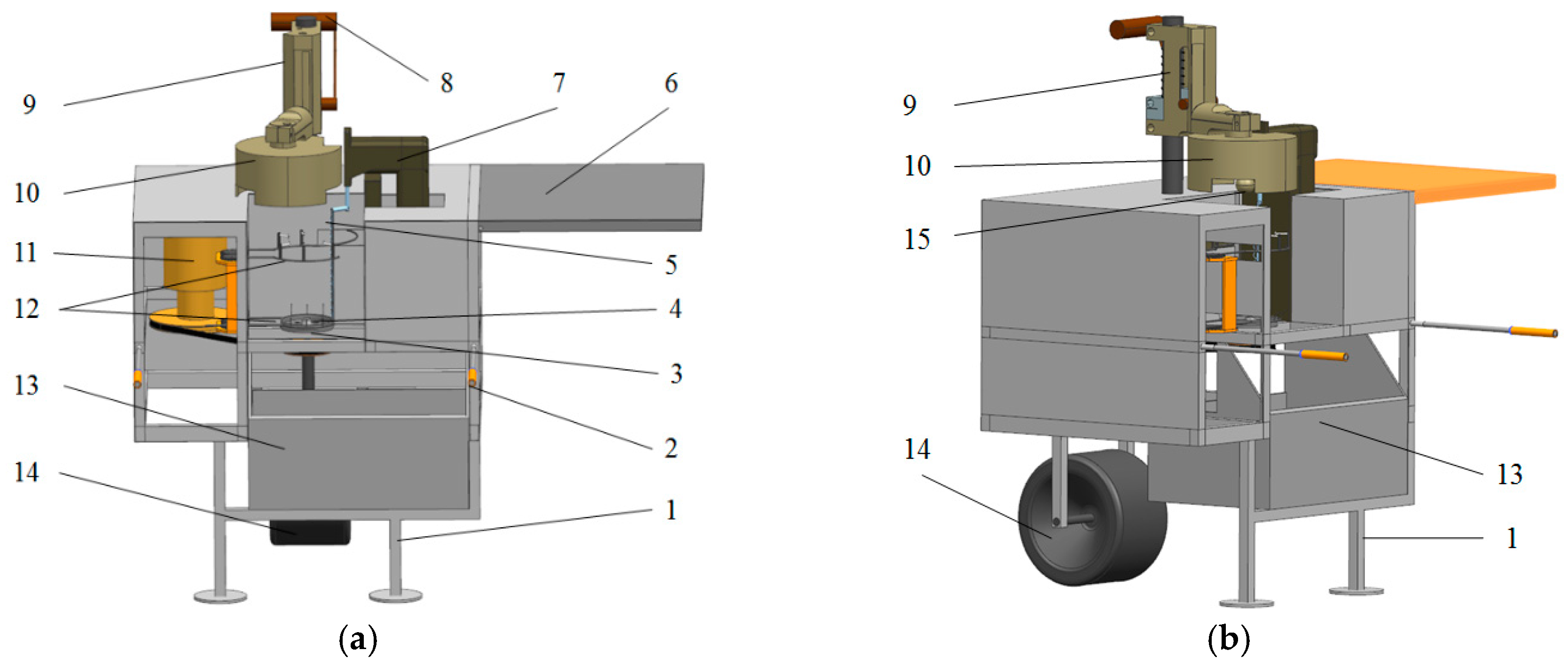

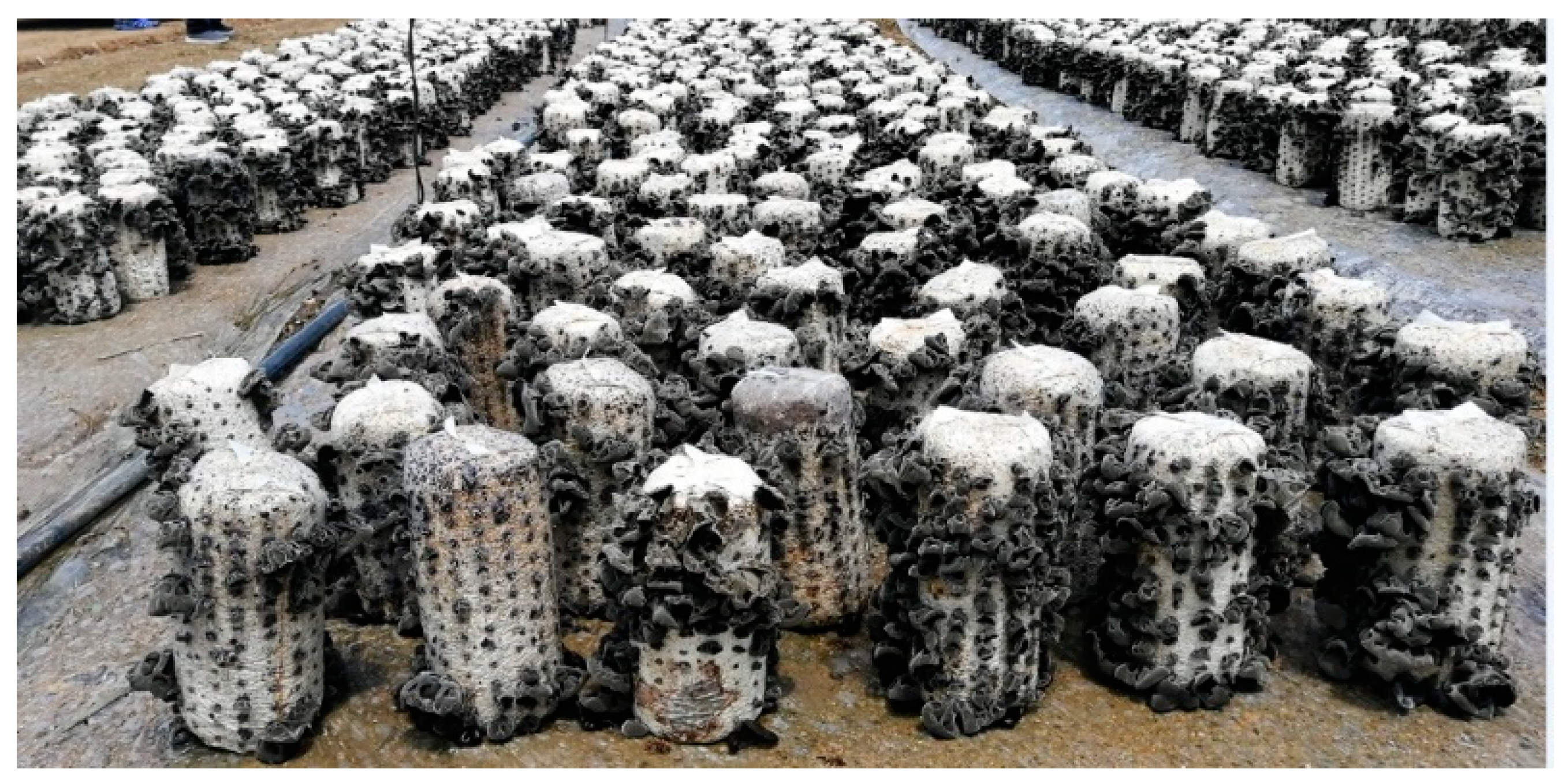
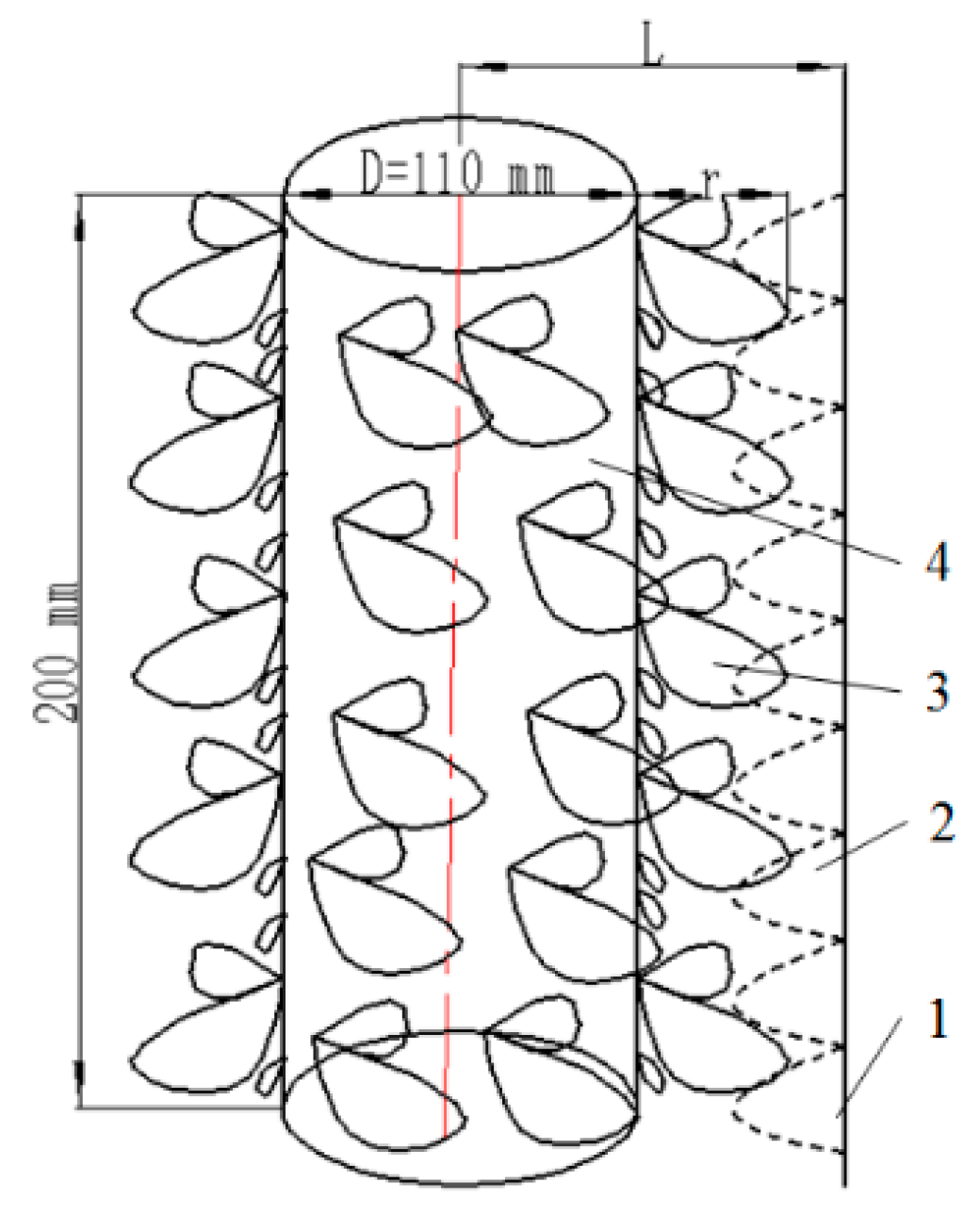

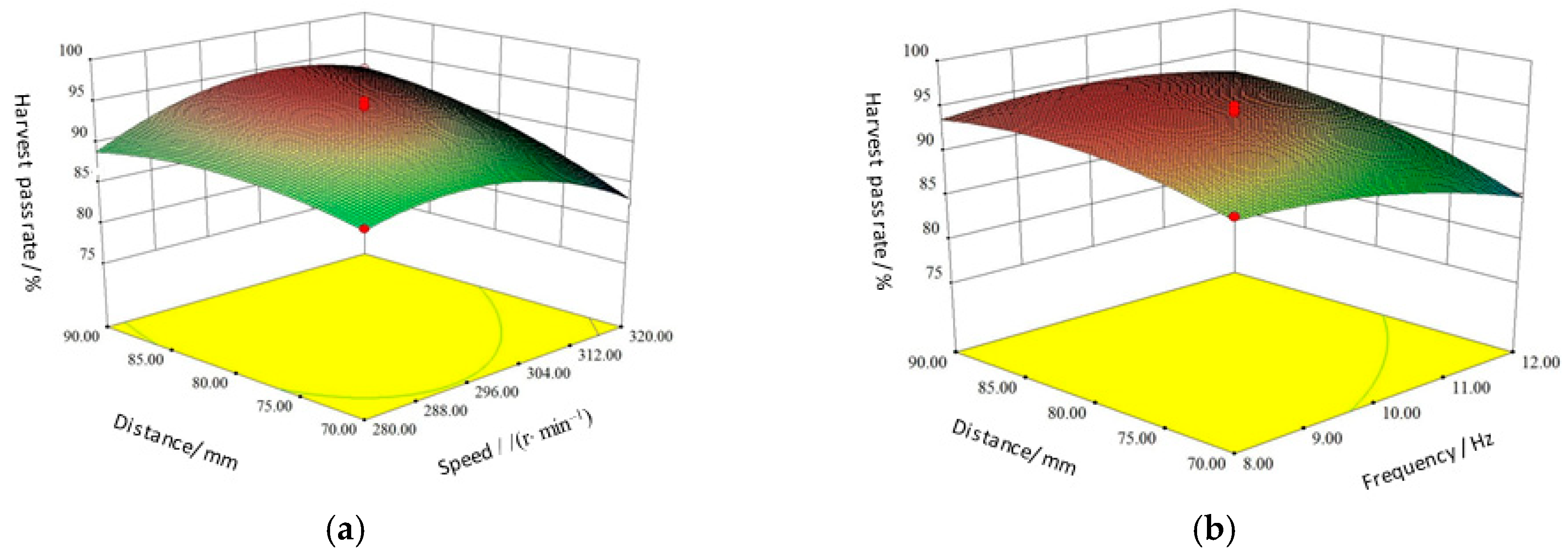
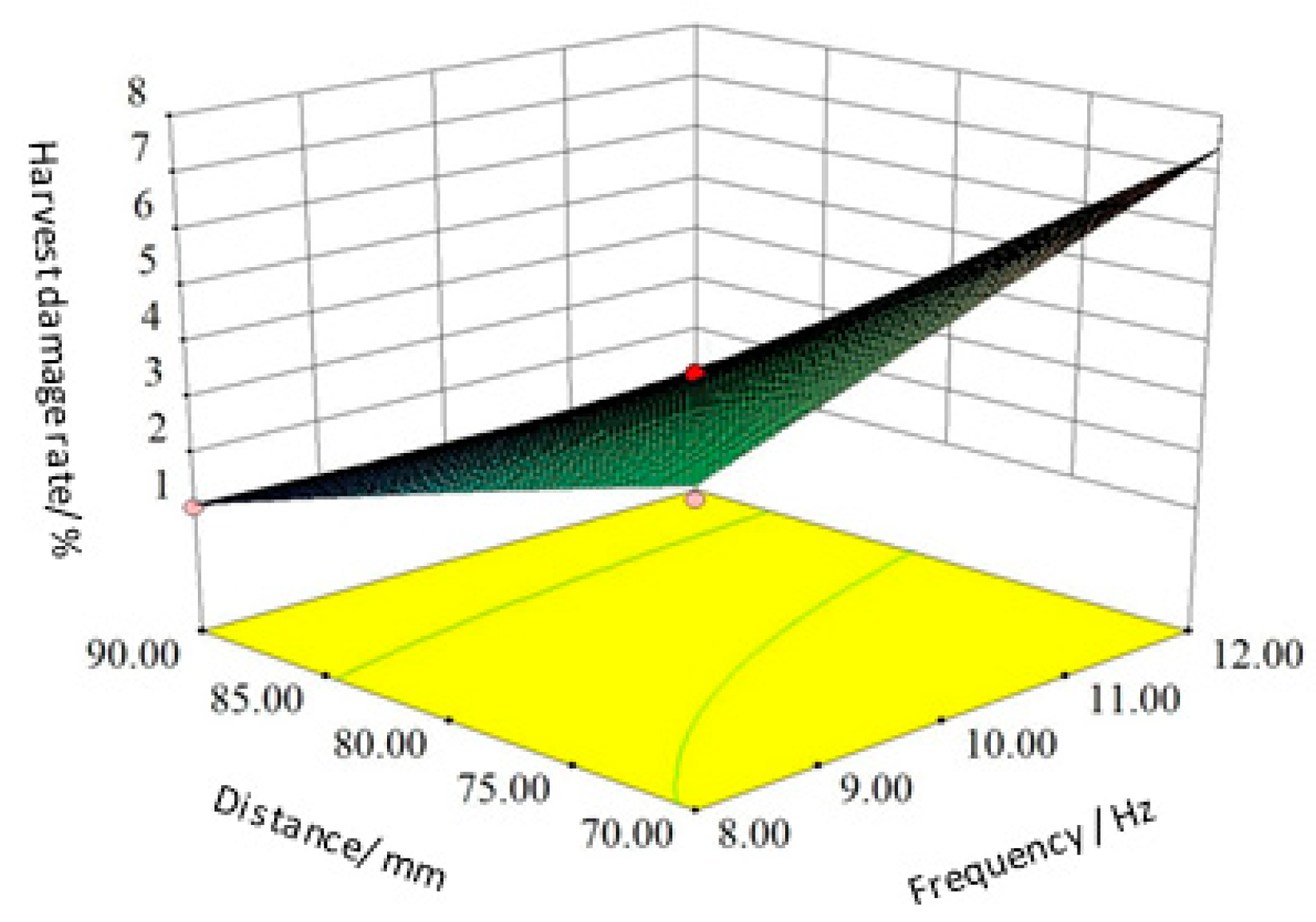
| Level | Speed/(r·min−1) | Frequency/Hz | Distance/mm |
|---|---|---|---|
| −1 | 280 | 8 | 70 |
| 0 | 300 | 10 | 80 |
| 1 | 320 | 12 | 90 |
| No. | Factors and Levels | Response Index | ||||
|---|---|---|---|---|---|---|
| Speed A | Frequency B | Distance C | Productivity Y1/(bag·h−1) | Pass Rate Y2/% | Damage Rate Y3/% | |
| 1 | 320 | 8 | 80 | 352 | 90.81 | 2.94 |
| 2 | 300 | 10 | 80 | 372 | 94.35 | 3.46 |
| 3 | 300 | 12 | 70 | 368 | 84.83 | 7.69 |
| 4 | 300 | 12 | 90 | 348 | 91.52 | 1.12 |
| 5 | 320 | 12 | 80 | 376 | 89.25 | 3.73 |
| 6 | 300 | 8 | 90 | 340 | 91.43 | 0.81 |
| 7 | 300 | 10 | 80 | 366 | 93.85 | 3.31 |
| 8 | 300 | 10 | 80 | 369 | 94.61 | 3.11 |
| 9 | 280 | 12 | 80 | 346 | 87.03 | 4.12 |
| 10 | 320 | 10 | 70 | 361 | 82.67 | 6.57 |
| 11 | 280 | 10 | 70 | 349 | 88.48 | 4.86 |
| 12 | 300 | 10 | 80 | 361 | 93.81 | 4.02 |
| 13 | 280 | 8 | 80 | 352 | 90.04 | 2.73 |
| 14 | 300 | 10 | 80 | 364 | 95.13 | 3.13 |
| 15 | 300 | 8 | 70 | 358 | 91.35 | 3.86 |
| 16 | 280 | 10 | 90 | 330 | 86.49 | 0.92 |
| 17 | 320 | 10 | 90 | 342 | 92.64 | 0.96 |
| Index | Source | Square | df | Mean Squares | F | p |
|---|---|---|---|---|---|---|
| Y1 | Model | 2482.06 | 9.00 | 275.78 | 24.85 | 0.0002 ** |
| A | 243.00 | 1 | 243.00 | 21.89 | 0.0023 ** | |
| B | 120.33 | 1 | 120.33 | 10.84 | 0.0133 * | |
| C | 16.56 | 1 | 16.56 | 1.49 | 0.2615 | |
| OFF | 225.00 | 1 | 225.00 | 20.27 | 0.0028 ** | |
| AC | 0 | 1 | 0 | 0 | 1.00 | |
| BC | 1.00 | 1 | 1.00 | 0.09 | 0.7728 | |
| A2 | 337.27 | 1 | 337.27 | 30.39 | 0.00091 ** | |
| B2 | 3.80 | 1 | 3.80 | 0.34 | 0.5768 | |
| C2 | 601.27 | 1 | 601.27 | 54.17 | 0.0002 ** | |
| Residual | 77.70 | 7.00 | 11.10 | |||
| Lack of fit | 4.50 | 3.00 | 1.50 | 0.082 | 0.9664 | |
| Pure error | 73.20 | 4.00 | 18.30 | |||
| R2 | 0.9696 | |||||
| Adjustment of R2 | 0.9306 | |||||
| Coefficient of variation /% | 0.94 |
| Index | Source | Square | df | Mean Squares | F | p |
|---|---|---|---|---|---|---|
| Y2 | Model | 207.35 | 9.00 | 23.04 | 59.49 | <0.0001 ** |
| A | 6.21 | 1 | 6.21 | 16.03 | 0.0052 ** | |
| B | 25.84 | 1 | 25.84 | 66.73 | <0.0001 ** | |
| C | 68.52 | 1 | 68.52 | 176.93 | <0.0001 ** | |
| OFF | 0.53 | 1 | 0.53 | 1.36 | 0.2822 | |
| AC | 35.76 | 1 | 35.76 | 92.34 | <0.0001 ** | |
| BC | 10.92 | 1 | 10.92 | 28.21 | 0.0011 | |
| A2 | 55.79 | 1 | 55.79 | 144.05 | <0.0001 ** | |
| B2 | 8.58 | 1 | 8.58 | 22.16 | 0.0022 | |
| C2 | 41.51 | 1 | 41.51 | 107.20 | <0.0001 ** | |
| Residual | 2.71 | 7.00 | 0.39 | |||
| Lack of fit | 1.49 | 3.00 | 0.50 | 1.64 | 0.3157 | |
| Pure error | 1.22 | 4.00 | 0.30 | |||
| R2 | 0.9871 | |||||
| Adjustment of R2 | 0.9705 | |||||
| Coefficient of variation/% | 0.69 |
| Index | Source | Square | df | Mean Squares | F | p |
|---|---|---|---|---|---|---|
| Y3 | Model | 55.14 | 9.00 | 6.13 | 28.60 | 0.0001 ** |
| A | 0.87 | 1 | 0.87 | 4.08 | 0.083 | |
| B | 8.07 | 1 | 8.07 | 37.67 | 0.0005 ** | |
| C | 15.26 | 1 | 15.26 | 74.25 | <0.0001 ** | |
| OFF | 0.090 | 1 | 0.090 | 0.42 | 0.5375 | |
| AC | 0.70 | 1 | 0.70 | 3.26 | 0.1142 | |
| BC | 3.10 | 1 | 3.10 | 14.46 | 0.0064 ** | |
| A2 | 4.94 × 10−3 | 1 | 4.94 × 10−3 | 0.023 | 0.8836 | |
| B2 | 2.87 × 10−3 | 1 | 2.87 × 10−3 | 1.34 × 10−3 | 0.9718 | |
| C2 | 8.24 × 10−3 | 1 | 8.24 × 10−3 | 0.038 | 0.8500 | |
| Residual | 2.71 | 7.00 | 0.21 | |||
| Lack of fit | 1.49 | 3.00 | 0.32 | 2.28 | 0.2211 | |
| Pure error | 1.22 | 4.00 | 0.14 | |||
| R2 | 0.9735 | |||||
| Adjustment of R2 | 0.9395 | |||||
| Coefficient of variation/% | 13.72 |
| Survey Group | Productivity/(bag·h−1) | Pass Rate/% | Damage Rate/% |
|---|---|---|---|
| 1 | 350 | 92.05 | 3.21 |
| 2 | 346 | 91.34 | 3.10 |
| 3 | 345 | 90.62 | 3.32 |
| 4 | 342 | 90.75 | 3.25 |
| 5 | 347 | 91.68 | 3.18 |
| 6 | 346 | 92.14 | 3.09 |
| Average value | 346 | 91.43 | 3.19 |
| Standard deviation | 2.38 | 0.59 | 0.08 |
Publisher’s Note: MDPI stays neutral with regard to jurisdictional claims in published maps and institutional affiliations. |
© 2022 by the authors. Licensee MDPI, Basel, Switzerland. This article is an open access article distributed under the terms and conditions of the Creative Commons Attribution (CC BY) license (https://creativecommons.org/licenses/by/4.0/).
Share and Cite
Wang, M.; Wang, S.; Zhou, D.; Wang, J.; Ding, T.; Ma, S.; Song, W. Optimization and Experiment on Key Parameters of Harvester for Auricularia auricula. Agriculture 2022, 12, 1778. https://doi.org/10.3390/agriculture12111778
Wang M, Wang S, Zhou D, Wang J, Ding T, Ma S, Song W. Optimization and Experiment on Key Parameters of Harvester for Auricularia auricula. Agriculture. 2022; 12(11):1778. https://doi.org/10.3390/agriculture12111778
Chicago/Turabian StyleWang, Mingyou, Shuaiyang Wang, Dehuan Zhou, Jiaoling Wang, Tianhang Ding, Shixin Ma, and Weidong Song. 2022. "Optimization and Experiment on Key Parameters of Harvester for Auricularia auricula" Agriculture 12, no. 11: 1778. https://doi.org/10.3390/agriculture12111778




